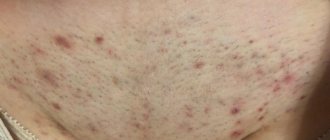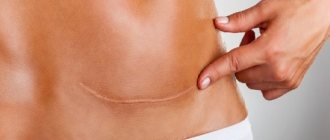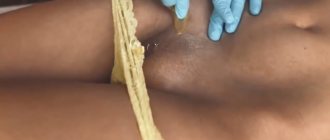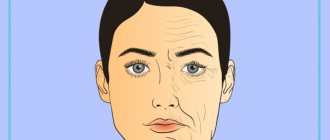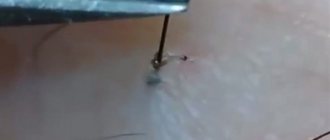Body hair is a common problem that almost all representatives of the fair sex try to combat. Every girl dreams of always having well-groomed and smooth skin, and for this they look for any possible methods of hair removal that give a good effect and provide long-term results.
One of the most effective methods is laser hair removal . This procedure has a number of numerous advantages, and the result is visible even after the first visit to a cosmetologist. But this does not always happen. So, after a cosmetic hardware procedure, girls are often not happy with the result, because the hair does not fall out immediately or falls out, but not all of it. laser hair removal really ? We invite you to look into this topic together and get answers to these questions.
We also suggest reading the article “Laser hair removal. Peculiarities"
What is laser hair removal
Laser hair removal is a cosmetic procedure that is carried out using a special device: its beam targets the coloring pigment - melanin. The laser penetrates the hair follicle and destroys its structure from the inside, thus preventing future hair growth. This procedure is most effective on dark-colored hair.
After the first session, you will not get perfectly smooth skin, but the results will still be noticeable. Thin and soft hairs will disappear without a trace, while hard hairs will become less noticeable. Remember that to achieve maximum effect, it is recommended to conduct several sessions, since laser hair removal is a course procedure. This is primarily due to the characteristics and stages of hair development, as well as the affected area. Only a specialist can determine the exact amount. As a rule, this is from 3 to 8 sessions.
Recommended articles on the topic:
- Laser stretch mark removal in a beauty salon: pros and cons of the procedure
- Thermal detoxification: lightness of the body and clear skin
- Laser scar resurfacing is a modern way to get rid of skin imperfections
The service for removing unwanted hair using a laser is provided by most beauty salons, and signing up for them is not difficult. The main thing is to make sure there are no contraindications.
What types of lasers are used in epilation to remove hair?
Several types of laser can be used for hair removal.
- The ruby laser is very effective for fair skin and dark hair color. Its beam penetrates shallowly under the skin. During the process of thermal exposure, unwanted vegetation is eliminated in approximately 5 sessions.
- The Alexandrite laser is considered one of the most effective devices. It is used in a large number of salons, as its effectiveness is quite high. If the procedure is carried out according to all the rules, then there is no pain and complications are practically excluded.
- The peculiarity of the diode laser is that it is able to penetrate into the deep layers of the epithelium, thereby achieving maximum effect. However, the procedure takes longer. Effective when working with any type of hair.
- A neodymium laser allows you to achieve the most lasting and long-lasting (up to 5 years) hair removal effect. Its main distinguishing feature is that the action of the beam is directed directly at the hair follicle and the vessel that nourishes it.
Skin care conditions during the course
During the course of sessions you will also have to adhere to certain conditions. Firstly, so as not to harm your skin, and secondly, to achieve maximum effect. The specialist will tell you in detail how to care for your skin and most likely these will be the following recommendations:
- After laser exposure, the skin will definitely have to be treated with antiseptics and medications. Which ones the doctor will tell you exactly. Basically, these will be products containing panthenol.
- Laser hair removal is a thermal treatment. Therefore, the skin will have to be constantly moisturized with various creams.
- Redness may occur after the session, so you should stock up on cooling wipes and other products.
- You can shave only when your doctor tells you to; at first, it may seem like your hair is growing rapidly. Actually no, they are pushed to the surface.
- After the procedure, it is better to avoid exposure to sunlight, as well as visiting baths, saunas, and hot springs.
- At first, it is better to avoid visiting massage rooms. The fact is that massage can cause blood flow and accelerated hair growth.
It is important to follow all doctor's recommendations. The skin after the session becomes very sensitive, so if you do not follow all the recommendations, you can greatly harm the skin and not only not get rid of hair, but also provoke skin diseases.
Laser hair removal on the face: stages and nuances of the procedure
Laser hair removal will help get rid of hair on the chin, cheeks or upper lip. They not only make women feel uncomfortable, but can even lower their self-esteem.
Especially considering the fact that it is currently important to grow hair on the head and get rid of it in all other places by any available means. Hair on a woman’s face does not look aesthetically pleasing and spoils even the most attractive appearance. Therefore, in pursuit of beauty, women strive to get rid of unnecessary hair. One of the most effective methods is laser hair removal.
There are, of course, other options. This includes shaving, waxing, sugaring and plucking, and depilatory creams. The options mentioned are the simplest and most tested, but, alas, their results do not last long, and there are also restrictions on use on the skin of the face.
Effect duration
Facial hair grows very quickly (remember men, many of whom are forced to shave every day), and it is necessary to constantly fight for smooth skin. Women have to pluck regrown eyebrow hairs almost every day, and newly epilated mustaches become visible again within a few days after the procedure.
Unlike waxing, shaving, and depilatory creams, which have side effects (ingrown hairs, infections, irritation), laser hair removal has proven to be the most effective and safe method of facial hair removal. All of the above methods of getting rid of unwanted hair have a short-lived effect, while laser hair removal allows you to forget about the problem once and for all, provided you complete a course of procedures.
06/04/2006 Re-growth of hair after the first procedure
I shaved my armpits a couple of days ago and need to shave again. The hair is certainly growing, but it is still a little thinner than usual.
I didn't have any ingrown hairs the entire time after treatment. I usually have 2 – 3 small, ingrown hairs under my arms and 1 – 5 in my bikini area. I currently have large ingrown hairs in my bikini area. It looks like there are only big hairs in the bikini area that have grown in forever. The ingrown hairs that I had before the first procedure have only now started to go away. I'm not sure, but I think the treatment made the ingrown hairs shorter because the hairs don't continue to grow because they have a harder time breaking through the skin.
When I shaved my bikini area this morning, it looked as if the hair had been waxed several weeks ago, some of the hair was long, some of the hair was short. My hair has become thinner, but still as black as before the first laser treatment. Shaving became a little easier, just like after weeks of waxing. I'm guessing my hair will grow back much like before until my next laser hair removal treatment later this month.
My upper lip looks almost the same as it did before the first laser treatment. The hair is a little less black, but there is still quite a bit of long black hair, as well as a lot of blonde hair. The only thing that disappoints me about laser hair removal is that the laser had no effect on blonde hair.
Several black hairs appeared around the nipples on the chest, just like before the treatment.
Minimal impact on skin
The skin of the face is thinner and more delicate than other areas of the body, so methods that are good, for example, for removing hair on the legs, are not suitable for epilating the face. Especially if the skin is prone to irritation and rashes or is simply sensitive. Thus, it is not recommended to use an electric epilator on your face. And most depilatory creams contain harsh chemicals that cause irritation.
Waxing is often practiced to remove facial hair. This method is quite capable of making the skin smooth for one or two weeks, but it has negative sides. Firstly, the procedure is painful, and secondly, the effect of ingrown hair may occur, pinpoint redness and pustular inflammation at the site of hair removal are possible.
Laser hair removal rids the facial skin not only of hair, but also of the troubles that accompany its removal. After all, the effect on the skin is short-term (milliseconds), non-traumatic (the laser destroys the hair structure without affecting the surrounding tissues) and practically does not cause pain or discomfort.
Despite all its advantages and effectiveness, this procedure still has a number of limitations:
- diabetes;
- herpes or other infectious processes in the body;
- oncological diseases;
- the period of bearing a child or breastfeeding;
- exacerbation of allergies;
- abrasions or cuts at the site of intended impact;
- moles on the face;
- tendency to form keloid scars;
- respiratory or viral diseases;
- age up to 18 years.
The procedure is divided into several stages, each of which is carried out by a doctor in a clinic or beauty salon. In order for everything to be successful, preparation for laser hair removal must be done correctly. This issue must be taken very seriously to avoid complications. Consultation with a dermatologist is required (you need to find out about your personal tolerance to the procedure, based on skin and hair color).
After making sure that there are no contraindications, you need to start preparing for it about a week before the procedure. Laser hair removal will be more effective if you adhere to the following recommendations:
- Before exposure to an energy beam, it is recommended to test for possible allergic reactions;
- do not sunbathe;
- 1–2 days before the procedure, adjust the hair length on the desired area of the skin (use a razor for this);
- Do not apply cosmetics to your face on the day of the procedure.
Before hair removal, the doctor who will perform it must examine the client, paying special attention to the skin, and discuss possible risks and contraindications. If there are no obstacles, the procedure proceeds in the following order:
- The specialist examines the skin, determines the phototype, hair structure and adjusts the equipment: the optimal length and laser power.
- During laser hair removal, the client lies on a comfortable couch. His eyes and the doctor's eyes are protected by special glasses.
- If necessary, the cosmetologist trims the hair and treats the skin in the desired area.
- A special conductor gel is applied to the treated area to improve the properties of the laser.
- Depilation. A laser flash, which penetrates the skin to the depth of the hair follicles, heats them in a narrow direction. As a result, they are destroyed, and the hair in this place stops growing. The flash of facial hair removal lasts only a few milliseconds.
- Irradiated skin is treated with a restorative, soothing agent.
After exposure to the laser for several days, it is necessary to create a gentle regime for the face, avoiding mechanical, light and thermal effects. At this time it is not recommended:
- sunbathe;
- use scrubs and peelings;
- apply self-tanner.
In some cases, when the skin at the epilation site is irritated, you need to use soothing and moisturizing creams based on aloe vera.
Hair after laser hair removal that does not fall out immediately will continue to fall out for several more days. An important point: the laser is able to act exclusively on those follicles that are in the active stage, so for final + hair removal, an average of 4-6 sessions will be required.
After the full course, you will forget about the need to fight hair on your body or face. It is extremely rare for some girls to develop single hairs, but if such a problem does arise, then one session a year will be enough to maintain smooth skin.
Late complications
If we consider the group of late complications of laser and photoepilation, we can distinguish hypo- and hyperpigmentation, scars, paradoxical hypertrichosis, leukotrichia, bromhidrosis, hyperhidrosis, malignancy or dysplasia of nevi in the area of the procedure.
1. Hypo- and hyperpigmentation are mainly a consequence of skin burns that occur during laser hair removal. They are most often found in tanned patients and people with skin phototypes III-VI. It has been noted that hypopigmentation often occurs with stage I thermal damage to the skin, when the crust formed after a burn disappears. Hyperpigmentation occurs in patients who do not follow the rules of post-procedure care and begin to tan in the first 2 weeks after hair removal or do not use sunscreen on exposed areas of laser-treated skin. Hypo- and hyperpigmentation often appear in the area of post-burn scars.
To prevent these complications, it is recommended to perform laser hair removal in patients with skin phototypes III-VI using long-pulse Nd:YAG lasers. In addition, these patients can use whitening creams 2 weeks before the procedure.
During the procedure, it is important to choose the right radiation parameters and use reliable and effective methods of cooling the epidermis to prevent thermal injury.
In most cases, hypo- and hyperpigmentation are reversible phenomena, but if they persist for a long time, medications are used. To correct hyperpigmentation, whitening agents containing hydroquinone, azelaic acid, hydroxy acids, and glucocorticoids are prescribed. To correct hypopigmentation, copper-based preparations are used, but if they do not have the desired effect, you can resort to cosmetic tattooing.
2. Scars are the result of thermal damage to the skin below the basement membrane. If a burn wound becomes infected during the rehabilitation process, then in almost 100% of cases gross hypertrophic scar changes occur. It has been noticed that post-burn scars most often form on the neck and mandibular region. Depending on the anatomical location and genetic predisposition, atrophic, normotrophic, hypertrophic and keloid scars can occur.
Thus, Kluger et al. reported a case of development of a keloid scar in the tattoo area in a 41-year-old patient with skin phototype IIIB after laser hair removal of hair in the chest area. He had a history of keloid scars, which were successfully treated with triamcinolone injections. When analyzing this case, it turned out that the tattoo pigments acted as a chromophore that competed with the melanin of the hair follicle. As a result of the absorption of laser energy, the tattoo pigment heated up, which led to a burn of the skin and then the formation of a keloid scar.
Today, atrophic and normotrophic scars are treated with conservative methods, but with rather low effectiveness; their surgical treatment is possible. Laser ablative and non-ablative fractional photothermolysis is used quite actively and with a high degree of efficiency to smooth the skin surface in the scar area.
Pathological scars , which include hypertrophic and keloid scars, are treated with intradermal injections into the scar area of prolonged forms of glucocorticoids (Kenalog, Diprospan). Russian scientists have recently proposed a new and quite effective method for treating pathological scars - the use of a copper vapor laser.
3. Paradoxical hypertrichosis - increased hair growth after laser and photoepilation procedures. According to data from various sources, stimulation of hair growth occurs in women with skin phototypes III-VI, mainly on the face and neck, on the border between the treated and untreated zones. Several mechanisms may be involved in the development of this complication:
- Treatment using low (subthreshold) energy flux density, which does not destroy the hair follicle, but has a stimulating effect on hair growth.
- Thermal-inflammatory effect - activation of “dormant” follicles and stimulation of telogen phase hair growth in areas bordering epilation.
Prevention of this complication is to use an energy flux density sufficient to remove hair. To correct paradoxical hypertrichosis, long-pulse Nd:YAG lasers are used.
4. Leukotrichia, bromhidrosis, hyperhidrosis. One interesting retrospective study was conducted in 2009. According to the data obtained, with laser hair removal in the armpit area, complications such as hyperhidrosis, bromhidrosis and leukotrichia may develop. Hyperhidrosis was observed in 11% of patients, mainly with skin phototypes II and V, when a combination of two lasers was used during the procedure - diode and alexandrite. The development of bromhidrosis (4% of cases) and leukotrichia (2%) did not have any significant correlation with age, skin phototype and type of laser radiation.
5. Dysplasia and malignancy of nevi in the area of laser hair removal. Do not forget about the possibility of degeneration of melanocytic nevi in the hair removal area. Nevus melanin is a competing chromophore and absorbs laser radiation along with hair follicle melanin. As a result of repeated exposure to laser radiation or pulsed light (IPL system), thermal damage to melanocytic formations occurs, their growth is activated, and atypical cells appear, which can ultimately lead to the development of melanoma.
Prevention of this complication is not to subject skin areas with any neoplasms to laser hair removal. If there are nevi in the affected area, and hair removal is still carried out, then the nevi must be covered with special protective devices.
So, avoiding complications and minimizing side effects is one of the main tasks of a doctor in aesthetic medicine. When performing laser hair removal, there is not only the risk of choosing high radiation parameters, leading to overheating of the skin and associated complications, but also the risk of playing it safe - choosing parameters that are insufficient to solve the problem for a given patient and, as a result, ineffective, which can lead not only to the absence of desired effect, but to the appearance of the exact opposite. Laser hair removal, which seems like such a simple procedure, can cause serious complications if performed incorrectly. In order to avoid this, you should be thoughtful about the appointment of procedures and carefully collect anamnesis. When choosing the type and parameters of exposure, the individual characteristics of the patient should be taken into account, especially the presence of tanning, skin phototype and its condition in the area of influence. And of course, it is very important to have professional knowledge of the equipment that you use in your work, to know the specifics of each laser and each photosystem.
Literature
- Klyuchareva S. V., Selivanova O. D. Correction of side effects of laser therapy and pulsed light sources in dermatology and aesthetic medicine. Russian Journal of Skin and Venereal Diseases 2009; No. 4:36-40.
- Pozdeeva E. V. Acceleration of hair growth during hair removal procedures using light methods: an incident or a pattern? Cosmetics and Medicine 2009; No. 6:44-47.
- Alster TS Complications of phototherapy using laser and intense pulsed light // Laser and light therapy. - M.: Reed Elsiver, 2010. T. 2, p. 135-137.
- Carter JJ, Lanigan SW Incidence of acneform reactions a. er laser hair removal. Lasers Med Sci 2006; 21:82-85.
- Chan HHL, Kono T. Laser therapy in patients with dark skin // Laser and light therapy. - M.: Reed Elsiver, 2010. T. 2, p. 88-103.
- Choi CM, Dover JS Laser hair removal // Laser and light therapy. - M.: Reed Elsiver, 2010. T. 1, p. 134-153.
- Goldman MP, Fitzpatrick RE Laser resurfacing of the neck with the erbium laser. Dermatol Surg 1999; 25:164-167.
- Greve B., Raulin C. Professional errors caused by lasers and intense pulsed light technology in dermatology and aesthetic medicine: preventive strategies and case studies. Dermatol Surg 2002; 28:156–161.
- Helou J., Soutou B., Jamous R., Tomb R. Novel adverse effects of laser-assisted axillary hair removal. Ann Dermatol Venereol 2009; 136:495–500.
- Kluger N., Hakimi S., Del Giudice P. Keloid occurring in a tattoo a. er laser hair removal. Acta Derm Venereol 2009; 89:334–335.
- Lim SP, Lanigan SW A review of the adverse effects of laser hair removal. Lasers Med Sci 2006; 21:121-125.
- Rasheeed Al. Uncommonly reported side effect ects of hair removal. J Cosmet Dermatol 2009; 8:267–274.
- Shulman S., Bichler I. Ocular complications of laser-assisted eyebrow epilation. Eye 2009; 23:982–983.
Basics and subtleties of laser hair removal on legs
According to modern standards, the beauty of the human body is not only correct proportions and well-trained muscles, but also impeccable smoothness of the skin. One of the indicators of beautiful and well-groomed skin of the legs is the absence of excess vegetation on it.
Laser hair removal will forever eliminate the need to shave your legs every day.
How painful is laser hair removal?
Laser hair removal today is considered a procedure during which there is no pain or discomfort. Because of this, it is used to remove hair not only on the legs, but also on sensitive areas such as the intimate area or armpit area. But everything in the world is relative, and everyone has their own pain sensitivity threshold.
Laser hair removal is a godsend for those who are afraid of traumatic techniques like waxing or sugaring. But compared to shaving with a conventional machine, this method of hair removal does not feel so harmless. It is no coincidence that many resort to pain relief before laser hair removal. If you are not able to endure even the slightest pain, feel free to request anesthesia - embarrassment in this case is inappropriate, mental health is more important.
We recommend
Laser aesthetic cosmetology: the perfect technique for an ideal appearance Read
more By the way, the pain threshold in women differs in different phases of the menstrual cycle, and according to some data, it also depends on the time of day. During PMS, the pain is felt much more intense than after the start of menstruation. So the optimal time for the hair removal procedure (without discomfort) will be the days from the fourth to the seventh cycle. The best time of day is from 15 to 16 hours.
Some modern laser machines have a special attachment for cooling the skin during hair removal - this significantly reduces pain. If there is no such attachment, you can apply ice to your feet before the procedure and hold it for a while to reduce sensitivity.
Causes of complications
Let us list the main reasons for the development of complications characteristic of all types of procedures using lasers and IPL systems.
- Professional errors of a doctor, which include poor quality training; diagnostic errors, especially in determining the phototype and skin condition; incorrect choice of laser type and its radiation parameters; failure to carry out test exposure; imperfection of laser technology; incomplete patient awareness of the procedure, its results and post-procedure care; lack of eye protection for the patient or doctor; lack of adequate cooling of the skin during the procedure.
- Failure of patients to comply with doctor’s recommendations for post-procedure care.
- The patient's health condition during the procedure. This factor affects the effectiveness of the procedure itself and the development of complications in the post-procedure period. Even with a high-quality history collection, we cannot fully take into account the presence of all aggravating factors and diseases in the patient, since he does not always know about them.
When collecting anamnesis, it is important to take into account the patient’s tendency to allergic reactions, the presence of hormonal disorders, immunodeficiency conditions, connective tissue diseases and tumor diseases, and the patient’s taking medications that affect the functional activity of melanocytes.
Preparing for the hair removal procedure
The following steps will help you prepare for laser hair removal on your legs:
- At least 3 weeks before the session, you cannot remove hair from the roots, that is, pull it out. This will make the first procedure as effective as possible.
- For 3 days, you should not use new skin care cosmetics on those areas of the body that will be exposed to the laser. This is due to the possible unpredictable reaction of the skin to an unfamiliar product.
- 2 days before the planned session, you must stop using cosmetics that contain alcohol, so as not to disturb the normal water-fat state of the skin, as this can lead to irritation on it after the procedure.
- 1 day before the session, you need to shave the hair in the area that will be epilated with the laser.
Preparing for laser hair removal of the legs is an important point. This is the key to ensuring that everything goes as efficiently as possible.
05/10/2006 First results
I didn't shave my armpits for two days and they remained perfectly smooth. Hair began to fall out sharply in the bikini area. I rubbed the skin of my lower abdomen with a sponge until all the hair fell out. I noticed that I could pull them out with my fingers. (Like plucking, but without the roots, the hair just fell out.) I also noticed that the nurse who performed the laser hair removal procedure must have missed a small area in the bikini area, about two flashes in area. There is a strange patch of hair on the right side of the bikini area.
Laser hair removal procedure
Our hair has color - it can be black, chestnut, light brown, red. A pigment called melanin is responsible for this: it is what gives the hairs its characteristic shade. Melanin has a peculiarity: it absorbs Laser Hair Removal light waves with a length of about 700–1000 nm - this is exactly what the hair removal laser has. Due to this, the pigment heats up quite strongly.
Since melanin is concentrated in the hair shaft and hair follicle, it also warms them up. This temperature is enough to damage both the rod itself and the blood vessels that feed the follicle.
We recommend
Laser hair removal on the abdomen: contraindications, features of the procedure and care More details
The time of exposure to a hair is a fraction of a second, thanks to which the entire surface of the leg can be treated in a relatively short period of time.
Before starting the procedure, a competent specialist selects the settings of the laser hair removal device individually for each patient (taking into account the area of hair removal, hair color, skin color, etc.). In particular, the pulse parameters (power, energy) are selected in such a way that they are only sufficient to destroy the hair growth zone, and there is practically no effect on the melanin of the epidermis.
Important! Never ask the master to increase the power of the impact. This will not help achieve a better result (fewer sessions, shorter procedure time, etc.). In fact, this approach can lead not only to burns and subsequent scars, but also to more serious consequences.
Number of procedures and interval between sessions
The number of procedures depends on how much “dormant” hair the patient has and the period of its renewal. To achieve a more or less decent result, and this can be considered the need to undergo maintenance procedures no more than once a year, you need from 5 to 10 laser hair removal sessions with an interval of one to two months. Such an interval and frequency of procedures are necessary in order to cover “dormant” follicles that were in the stage of degradation or dormancy at the time of the previous procedure.
Consequences of the procedure
Certain cosmetic risks during hair removal are associated with skin damage. Depending on individual sensitivity, the following may occur:
- hyperpigmentation;
- burns;
- swelling;
- scarring.
Hyperpigmentation and swelling can be treated with a cold compress or cream with dexpanthenol. Burns and scars occur extremely rarely, sometimes due to the fault of the specialist who performed the hair removal. Before going to the salon, you should study information about it and read reviews.
There are no serious side effects from laser hair removal. Manipulation does not lead to exacerbation of gynecological diseases and does not contribute to their occurrence.
Cosmetologists in trusted clinics ask questions about the client’s health, find out the presence of chronic diseases, whether this technique has been performed before and what the consequences were.
Frequently asked questions about laser hair removal
1. How long does it take for hair to fall out after laser hair removal?
The principle of operation is the effect of laser radiation (light wave of a certain length) on the melanin pigment present in the hair. As a result, heated melanin, which has absorbed light energy, destroys the hair growth zone and the vessels feeding the hair follicle. The hair shaft, deprived of nourishment, disappears along with the root. After laser hair removal, hair falls out after about 7-10 days.
2. How long does hair not grow after laser hair removal?
It depends on individual characteristics. After laser hair removal, hair grows more slowly, and the result of completing the full course is a total elimination of unwanted hair. So, in the worst case, you will need to visit a cosmetologist’s office 1-2 times a year to remove individual “instances”.

